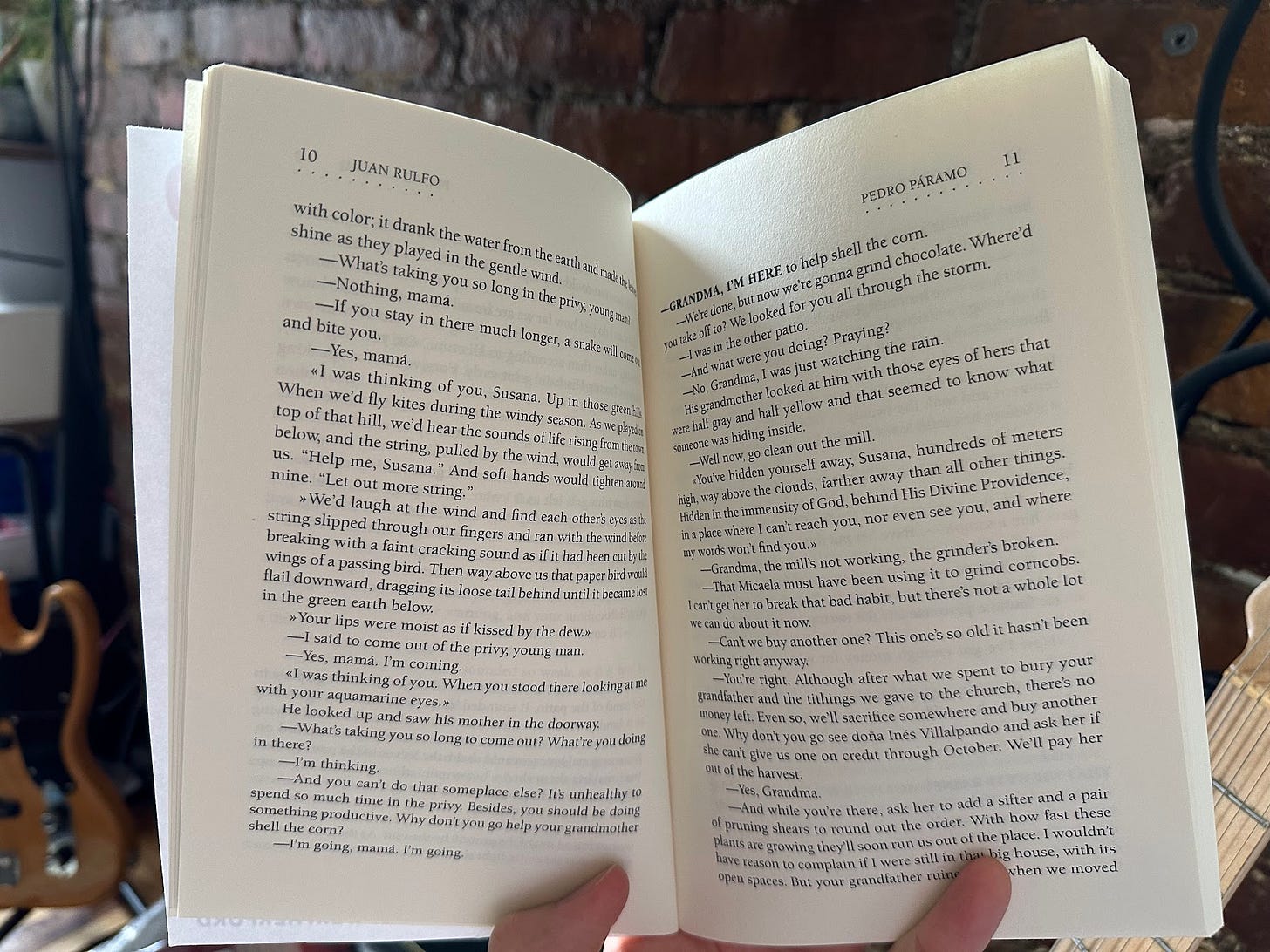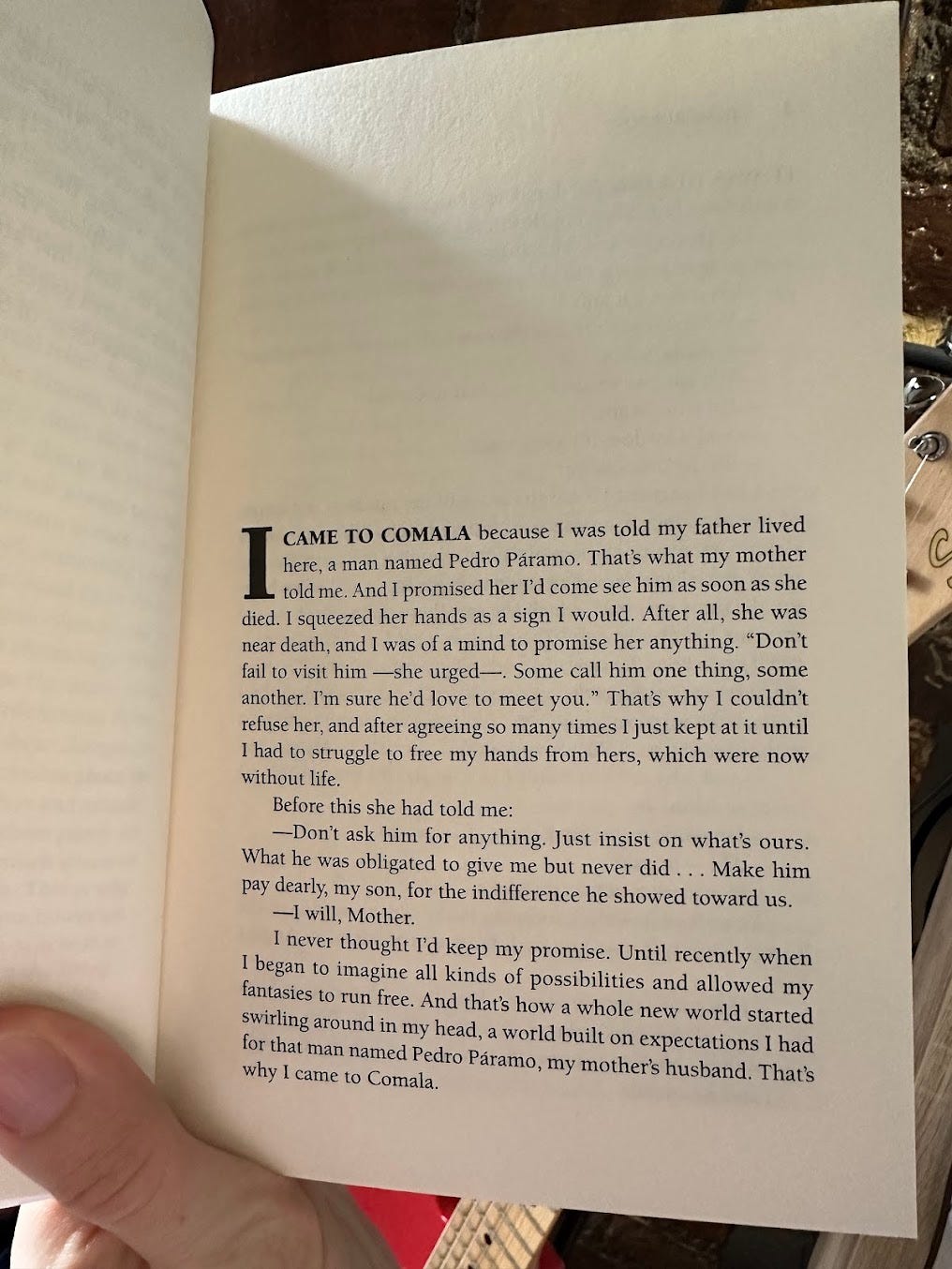Hi hello I’ve lost it and I’m gonna use technology to crack Pedro Páramo. Or at least develop a good guess at who’s actually talking in this book that looks like this:
You may be familiar with my previous slow, chapter-by-chapter, close reading jokes and analysis project Bad Books Good Times. But what if I told you instead of reading a bad book so you don’t have to read it, what I try to explain a confusing book for a reader who was also confused. I guess that’s just actually just SparkNotes now, but, nonetheless, let us journey into: wtf is Pedro Páramo
As barely explained on my other blog recently, Pedro Páramo might be the hot new inscrutable book you mostly see people reading on the New York subway more so than anyone (including the translator) will likely ever coherently say what it is. As I wrote last time: Pedro Páramo is a real Dark Souls of books–ass book, ostensibly about a man who travels to his estranged father’s hometown after his mother’s death, but maybe everyone there is a ghost, and someone is telling him about his shitty dad’s life but it’s not clear who and maybe they’re a ghost, maybe everyone is a ghost, aren't we all ghosts if you think about it?? It’s difficult in a way where the difficulty is the point, and god willing you might get what else is the point if you get really, really into it.
The story is nonlinear. There are dashes, double quotation marks, single quotation marks, and something called a guillemet which all get used to notate where dialogue is. On my first read of this book I never figured out when one was used vs another or why.
So, a few elements of my intended approach:
We’re going to go through this section-by-section. The book has no chapters, but is subdivided by small sections of a few pages each.
I’m using the note-taking program Obsidian to take notes. It’s my new go-to notetaking platform, and I’m going to attempt to use its built-in graph feature. It’ll automatically compose spider diagrams/webs connecting notes you’ve properly tagged; so this is not only a project to learn wtf this book is supposed to be about, but also how to use notetaking software. What a time to be alive.
I’m gonna stick to a close reading. Unless something really calls for outside research, I’m going to attempt a purely formalist lens of understanding what this book is about. (Formalism being a theory maintaining that, as my undergrad English advisor described, “the bookiness of the book is in the book”. If that doesn’t help you idk how else to explain this one.)
Sound good? Great. Let’s read the first section, which is literally just the first page. How hard could this possibly be.
Page 1
I know that makes it sound like I’m setting up a joke for an utterly inscrutable from the first page book, but this first page is misleading. First and foremost: it makes sense. We thus are set up to learn our first lesson about Pedro Páramo: this book is fiendish as fuck.
While we are not off to a particularly interesting start, we definitely can at least say we understand, possibly for the last time, what is going on:
Mom’s dead
Mom told her son her deathbed wish for him to go visit his father
Seems like overkill to have a whole blog series about so far. What do we know about the father?
Owes the main character for being a shitty dad
That’s it! More or less! How do our notes look so far?
Remember what you’re feeling right now, because one day soon we will long for this feeling of confidence.
We don’t know much about our main character or his mom (who is now dead) at this point. Honestly, I don’t even know if we can believe if any of the relationships we’re told about here are even true. Instead, what we definitely know is that we have been given a sense of what an unnamed person’s relationship with the titular Pedro Páramo is like. Dead mom’s given a mission to go find an estranged dad who wronged them. Not a revenge mission (“Just insist on what’s ours”), but a pay the piper kinda mission (“for the indifference he showed us”) that some bad feelings linger about (“Make him pay dearly, my son”). Sounds fine. Very first step of the hero’s journey. Even the splash of character the main character (currently our narrator) gives us to hook the reader is very Call To Adventure and/or Fresh Prince Theme Song:
I never thought I’d keep my promise. Until recently when I began to imagine all kinds of possibilities and allowed my fantasies to run free. And that’s how a whole new world started swirling around in my head, a world built on expectations I had for that man named Pedro Páramo, my mother’s husband. That’s why I came to Comala.
Honestly this isn’t that interesting to me to unpack. Having read the book once, I’m not really convinced the main character ever becomes much of an actual character. So let’s just move along. Glad he got past resisting the call or whatever.
What does Obsidian look like so far?
I am attempting to use a bunch of features I have never bothered learning before. For instance, I figured out how to open up a graph view specific to each note (eg, in the above screenshot, only nodes that are linked to the unnamed main character appear), but I haven’t figured out how to make color-coding from the overall project/graph view of everything carry over.
There’s gotta be a better way to do this. Prepare to read that sentiment a lot.
tl;dr wtf happened in Pedro Páramo today
Mom dead.








